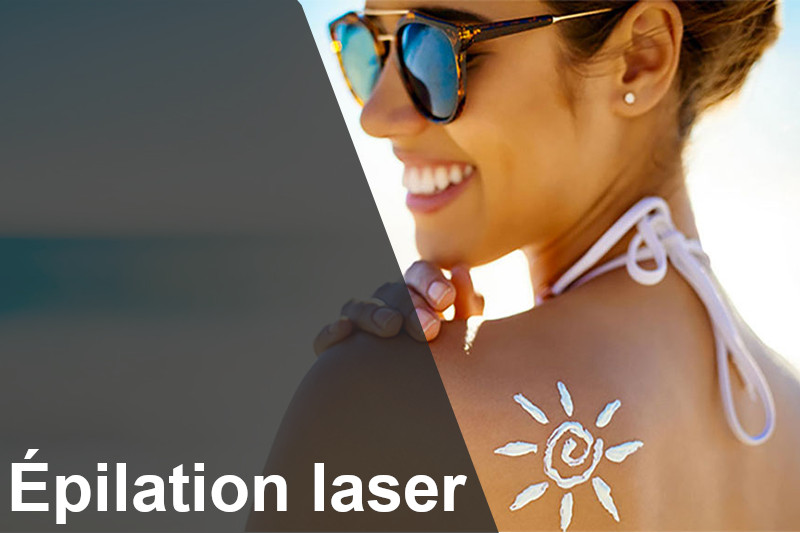
Laser hair removal and the sun: How long can you go without the sun before laser hair removal?
How can you manage laser hair removal and sunlight when we keep hearing that the two are not compatible?
Surely you don’t want to miss out on a vacation.
The Epilium & Skin aesthetic medicine center gives you all the tips you need to make the most of your laser hair removal while enjoying your vacation.
Is the sun compatible with laser hair removal?
The operating principle of laser hair removal is based on selective photothermolysis. In short, the light emitted by the laser beam is absorbed by the hair’s melanin, reaching the hair bulb and destroying the hair follicle once and for all, without damaging surrounding tissue.
Sun exposure triggers a rise in melanin on the skin’s surface.
The laser then confuses the melanin in the skin with that contained in the hair. The laser’s light energy will then be absorbed by the skin’s melanin, converting it into heat and causing skin burns.
It’s only after recent exposure to the sun, however slight, that laser hair removal and the sun are not compatible. The same applies to artificial tanning (UV) and self-tanning products.
Which lasers can be used to treat tanned skin?
Hair-removal lasers featuring the NdYag wavelength, originally designed for the treatment of dark to black skins, can also be used effectively on tanned skin without risk of burning.
The wavelength of this laser has a lower absorption by melanin than alexandrite, which means that laser hair removal and sunlight are manageable.
Lutronic’s advanced Clarity II technology offers a safer treatment when the skin is still tanned. The machines are equipped with sophisticated cooling systems that protect the skin by cooling the surface during treatment.
It is advisable to wait a few weeks after recent exposure before resuming treatment.
If in doubt, we will perform a test on the affected area to avoid any risk of burns.
What’s the best time of year to start permanent hair removal?
There are no rules; it all depends on your lifestyle. The number of laser hair removal sessions required for optimal results is between 6 and 10, depending on age, skin color, hair type and area treated.
Given that the sessions are spaced approximately 8 weeks apart, you will inevitably need to expose yourself to the sun for the duration of your treatment.
Don’t worry, it’s possible to manage the protocol without risk and ensure that your hair is eradicated even if you go out in the sun.
Talk to your practitioner during an initial consultation, and she’ll help you establish the most effective treatment plan.
When can I go out in the sun after a laser hair removal session?
It is advisable to wait two weeks after a laser hair removal session before exposing yourself to the sun, as the skin is sensitized after the treatment and this could lead to the appearance of pigmentation spots.
Take good care of your skin after your session, moisturizing it daily to avoid redness and irritation.
When you’re out in the sun, protect your skin with at least SPF 30 to avoid sunburn and brown spots.
How long should I avoid the sun before my laser hair removal session?
When you have a tan, the level of melanin on the skin’s surface increases.
The laser, which targets melanin in general, does not differentiate between that contained in the hair and that retained on the skin’s surface. The risk of burns is therefore not negligible.
We recommend that youavoid the sun for at least one month before your permanent laser hair removal session.
For the same reasons, don’t take any dietary supplements or apply self-tanning products four weeks before your treatment.
Why can’t laser hair removal for dark and black skin be used on tanned skin?
Dark to black skins contain a higher but stable concentration of melanin. The NdYag laser uses a wavelength that penetrates deeper into the skin and is suitable for this type of skin.
When black skin is tanned, a high concentration of melanin is present on the surface. This concentration of melanin will first absorb the laser beam’s energy, transforming it into heat and overheating the skin’s surface, risking burns. The heat won’t spread deep down.
What if I’m tanned and can’t get my laser hair removal session done yet?
When you return from vacation, your hair is bound to start growing back. This means you’re once again entering a phase of hair growth and it’s time for a waxing session. You can shave the hair with a manual razor or with depilatory cream. Above all, do not wax or tweeze, as the bulb must not be pulled out so that the hair cycle is not disrupted.
For facial or downy areas, electric or electrolysis hair removal can be used. This technique does not target the skin’s melanin and can be used on all skin phototypes at any time of the year. This involves inserting a filament as close as possible to the bulb, sending a very weak electric current to destroy it. The result is considered final.
If you have any doubts when you return from vacation, make an appointment at our Epilium & Skin center for a test to avoid any risk of potential burns.
Similar Posts
- Laser or Electric Hair Removal: Which solution to choose for long-lasting smooth skin?
- Number of ideal Laser Hair Removal Sessions
- Hormone-dependent women and permanent hair removal: laser or electric?
- Laser Hair Removal and Medication : Antibiotics, Antihistamines, Hormones,…
- Laser Hair Removal Decree 2024: A Revolution in Aesthetic Practice

